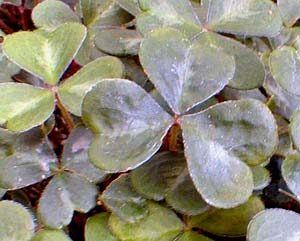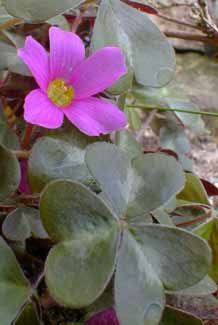
'Elfi's Pink'
Evergreen Oregon Oxalis,
or Redwood Sorrel
"Through crowfoot, with its golden lure,
And promise of far things,
And sorrel with its glance demure
And wide-eyed wonderings."
-Madison Cawein
(1865-1914)
(1865-1914)
Our original clump of Pete Ray's select strain of Oxalis oregana forma smalliana came from Nils Sundquist of Sundquist Nursery in nearby Poulsbo, so it has never lived outside of our county. Sundquist has a great eye for pleasing & unusual shade plants.
A couple of years after we planted this particular oxalis, we wanted more of it for another shady location, which needed more green that would last through much of the winter. The newest pots we obtained were labeled Oxalis oregana 'Elfi's Pink.' These were again grown by Pete Ray, though this time from his company Puget Garden Resources of Vashon Island. Ray is a well known local grower & hellebore hybridizer. I have to assume 'Elfi's Pink' is merely an unofficial cultivar name for the same select strain Ray has grown for some years.
 This species of oxalys is native of British Columbia, Washington, Oregon, & California, commonest in shaded Douglas fir & redwood forests.
This species of oxalys is native of British Columbia, Washington, Oregon, & California, commonest in shaded Douglas fir & redwood forests.As usually encountered, Oregon Oxalis is deciduous & has violet-tinted white flowers, very floriferous. But our variant form is evergreen & has rich pink flowers, fewer in number but persisting spring through early autumn. The second photo shows the flower in March.
The pink-flowering evergreen form is hardy but rather slow spreading by means creeping rhizomes. It is not an aggressive oxalis at all. The ordinary deciduous form would spread much faster.
It needs shade or partial shade. Although adaptable to more sun, it will not perform at its best in summer heat, & leaf-scorch can occur in full sun either in summer or winter, meaning it likes to be under evergreens rather than under deciduous trees. It is not at all drought tolerant & requires a persistently moist drained soil.
As a tightly packed groundcover of four to eight inches height, it is perfect for suppressing weeds, but short enough to fill in around herbaceous perennials. Such a high percentage of shade-garden perennials die back & vanish utterly in winter that it is very winning to have this oxalis filling in during the winter absence of many other things.
The trifoil clover-like leaves are a rich green with silvery dusting. The October (2003) leaf portrait at top captures the silvering well.
This oxalis is fully evergreen on Puget Sound, & is not even particularly scruffy-looking at winter's end just so long as it does not get too much winter sun & does not dry out. If gardened in conditions harsher than in our moderate area, it will partially die back or be winter-damaged or even die back altogether, but even then it will bounce back early in spring. It remains hardy even in much colder climates, but the degree of winter persistence lessens. Propagation is by division at about mid-September when it is finished blooming.